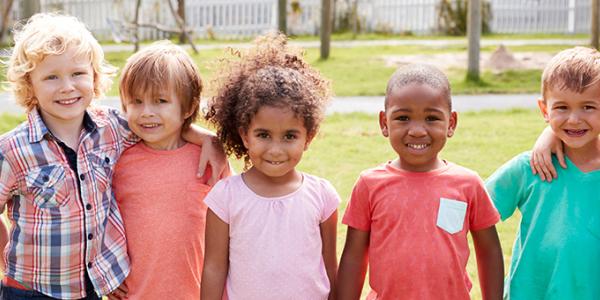To Prevent Bullying, Focus on Early Childhood

How do we prevent bullying? Despite decades of study and numerous programs claiming to be the solution to bullying, few programs have actually been shown to be effective. One of the main issues is that “bullying prevention” is often a misnomer; instead of trying to stop the behavior before it begins, the focus of many programs is on reducing already high rates of bullying. By the time students enter sixth grade, the earliest grade for which nationally representative data is collected, nearly 28 percent report having been targeted in the past year. For younger children, data are far more limited, but suggestive. The National Survey of Children’s Exposure to Violence found that 20.4 percent of children ages 2-5 had experienced physical bullying in their lifetime and 14.6 percent had been teased (verbally bullied).
To actually prevent bullying before it starts, we need to focus on how bullying behaviors develop—for those engaging in bullying behaviors and those being targeted—starting in early childhood. Child Trends recently conducted a literature review and convened an expert roundtable, which NAEYC took part in, to document current understandings of the roots of bullying in early childhood. We identified key contextual factors linked to bullying behaviors, promising and evidence-based programs that help address emerging behavior, and the need for further research.
Research on bullying and early childhood development is limited. When we talk about bullying, the early childhood audience is often forgotten. There remains immense debate in the field about how to distinguish between typical, sometimes aggressive behavior that young children show and the more strategic and deliberate behaviors that define bullying. In preparing their uniform definition of bullying, the Centers for Disease Control and Prevention defined bullying as being between “school-aged youth,” recognizing that the behaviors observed in young children are often not what we traditionally think of as bullying, but are developmental in nature, as children first begin to navigate interactions with peers. Many young children who are aggressive with their peers will not engage in bullying behaviors in later childhood and adolescence. Likewise, being the target of an aggressive behavior does not mean that child will be victimized for life. Still, these early aggressions (and conversely, the early skills of sharing, listening, and empathy) are precursors to later behavior, and it is important to intervene early. More research is needed to understand the trajectory of early aggression into bullying behaviors.
Despite the limited literature, four key factors consistently seemed to be related to bullying behaviors in young children:
1) Parents’ treatment of each other, their children, and others influences how young children treat their peers. Specifically, parents’ use of harsh discipline and children’s exposure to domestic violence are related to increases in bullying behavior, while parents’ positive engagement in their children’s lives, such as through interactive play, reading, and meals together, seems to be protective against bullying behavior. Parents serve as role models for their children, and modeling empathy, concern, and care for others may help deter later bullying. Resources such as those provided by the Making Caring Common Project at the Harvard Graduate School of Education can help parents expand their own “circle of concern” and help their children do so, too. (It should be noted here that the majority of current research looks at the behaviors and characteristics of mothers; studies looking at the role of fathers are more limited, primarily because mothers are more likely to be the primary caregiver for young children and more likely to respond to the research. Some effort is being made, however, to address the role of fathers in bullying prevention.)
2) Young children exposed to maltreatment are more likely to be involved in bullying, both as the target and the aggressor. Not only can maltreatment change children’s behaviors, it has been shown to fundamentally alter the development of young children’s brain structures, which can lead to developmental deficits including in the social and emotional domains. Early intervention is critical to help stem these delays. Adults and Children Together (ACT) Against Violence Raising Safe Kids, an evidence-based program specifically aimed at helping reduce child maltreatment and promote positive parenting strategies, is one approach that shows promise.
3) Television and other media can contribute to the development of both aggression and pro-social skills.Screen time for your children is one of the most debated subjects among early childhood advocates. Research shows that increased television watching is related to increases in aggressive behavior even if the content is not inherently violent. Conversely, when shows are specifically designed to promote skills such as sharing, empathy, and other pro-social skills—shows like Sesame Street, Daniel Tiger’s Neighborhood, or in past generations, Mister Rogers’ Neighborhood—children are more likely to engage in these behaviors after viewing.
4) Building young children’s social and emotional skills and promoting welcoming classrooms can significantly reduce aggression. Evaluations of several evidence-based social and emotional learning programs for young children, such as PATHS for Preschool, Second Step, and Al’s Pals, show that helping children understand and control their own emotions, and understand those of others, can significantly reduce conflict and aggression. Even without these formalized interventions, teachers of young children (and parents for that matter) can work to reduce bullying behaviors. The Guidance Matters column in the professional journal Young Children provides a number of resources that can support these efforts.
Overall, it is clear that more attention needs to be paid to identifying, researching, and preventing the roots of bullying behavior in young children. It is only when we recognize that bullying behaviors do not simply appear in elementary or middle school, but may be part of a developmental trajectory, that will we be able to stop bullying.
Deborah Temkin, Ph.D., is Program Area Director for Education at Child Trends
Kyle Snow is the former Director, Center for Applied Research at NAEYC